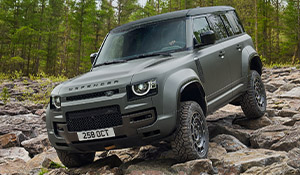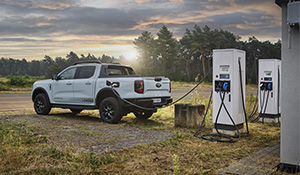Oldest Surviving 4x4 Nameplates
Four-wheel drives generally have a longer model lifecycle than passenger cars, but some nameplates take this to the extreme, including the ever-popular Toyota Land Cruiser and the Nissan Patrol, which can both trace their lineage back to the 1950s. Here are the Top 5 Oldest Surviving 4x4 Nameplates still available on the Aussie new-car market.
Toyota Land Cruiser – 1955
The Land Cruiser is the oldest of all Toyota nameplates. Although the vehicle’s origins date back to the first Toyota ‘Jeep’ BJ model of 1951, a Land Cruiser badge wasn’t slapped on the Toyota 4x4 until the launch of the 20 Series in 1955.
That first 20 Series Land Cruiser was used by Toyota to push into overseas markets, and several of these versatile 4x4s made their way down under thanks to Leslie Theiss, who secured the franchise to sell the vehicle in Australia and put a few them into service on the Snowy Mountains Scheme.

It was the 40 Series introduced in 1960 that really cemented the Land Cruiser nameplate into Australian 4x4 legend. Available in a variety of wheelbase lengths and body styles, and eventually with a choice of six-cylinder petrol and diesel engines, this was a four-wheel drive to suit everyone, whether farmers, miners, government departments or, for the first time, recreational four-wheel drivers.
The 40 Series was joined in 1967 by the 55 Series, which was a more comfortable wagon version of the Land Cruiser aimed squarely at the burgeoning recreational 4x4 market. This model was replaced by the more refined 60 Series Land Cruiser wagon in 1980, while the more commercial-oriented 40 Series continued to sell alongside it until 1984, when the 40 was replaced by the 70 Series.

The 70 Series Land Cruiser is still on sale today, albeit with several changes throughout the years. On the recreational side of the ledger, the 60 Series was replaced by the 80 Series in 1989, which in turn was replaced by the 100 Series in 1998 and then the 200 Series in 2008.

Today’s Land Cruiser line-up consists the 70 Series and 200 Series. The 70 Series is available as a mid-wheelbase 76 Wagon, a long-wheelbase 78 TroopCarrier and 79 Single and Double Cab Cab-Chassis models. All are powered by a 4.5-litre turbo-diesel V8 engine mated to a five-speed manual gearbox and a part-time 4x4 system. The auto-only 200 Series wagon is available with a 4.6-litre V8 petrol engine or a 4.5-litre twin-turbo-diesel engine, in various model grades ranging from around $84k to more than $120k.

Nissan Patrol – 1958
Like Toyota, Nissan began building 4x4s way back in 1951 with its Jeep-looking 4W Series. This Japan-market-only 4x4 was updated in 1955 with the introduction of the 4W61, and when the 4W65/4W66 models were launched in 1958 the vehicle finally scored its first Patrol badge.
The first Patrol exported to Australia was the 60 Series model, which was powered by a 4.0-litre six-cylinder petrol engine. The short-wheelbase variant was available with a soft-top (60) or hard-top (K60), while the longer wheelbase model (G60) was available as a wagon or pick-up.
The G60 is claimed to have made the first vehicular crossing of the Simpson Desert in the hands of geologist Reg Sprigg and his wife Griselda, who founded the Arkaroola Wilderness Sanctuary, although some reports suggest a Land Cruiser that was also on the trip was the first vehicle to complete the crossing.

The 60 Series was replaced by the 160 Series (MQ) Patrol in 1980, which still featured a separate chassis, live axles and leaf springs. There were now a choice of petrol and diesel engines, short and long wheelbases and hardtop, wagon, pick-up and cab chassis body styles.
The Y60 (GQ) was launched in late-1987 and was the first Patrol to be fitted with coil springs front and rear, although initially the cab-chassis variants still had leaf springs at the back.
The GQ was initially available with 4.2-litre petrol and diesel engines with either manual or automatic transmissions, and a smaller 3.0-litre petrol engine was added to the line-up in 1990. A 2.8-litre six-cylinder turbo-diesel was added in 1995, and the GQ Patrol continued until 1997, when it was replaced by the Y61 (GU) Patrol.

Although the GU Patrol had an all-new look, under the skin there were a lot of carryover parts from the GQ. Initially the GU was available with a 4.5-litre petrol six or a 2.8-litre electronically injected turbo-diesel six.
In mid-1998 the venerable TD42 4.2-litre naturally aspirated diesel was added to the line-up, and this was eventually fitted with a turbocharger in 1999 and labelled TD42T. With mechanical injection, this engine is still a favourite with bush tourers.
A modern four-cylinder 3.0-litre turbo-diesel (ZD30) was introduced in 2000 but this engine initially proved troublesome and despite improvements over the years it never really escaped its dubious past.

The TD42 and TD42T engines were dropped in 2006 due to emissions legislation, leaving the ZD30 as the only diesel option for Patrol buyers for the next 10 years, when the GU was eventually discontinued.
The petrol-only Y62 Patrol was introduced in 2013, and this model has recently been upgraded. With fully independent suspension, this refined 4x4 wagon is a far cry from Patrols of old. The current Nissan Patrol is available in Ti ($71,990) and Ti-L ($88,990) model grades and is powered exclusively by a 5.6-litre petrol V8 engine.

Range Rover – 1970
Although these days the Range Rover has evolved to become one of the world’s most luxurious 4x4s (with a price tag to match) the original Rangie launched back in 1970 was simply designed to be a passenger 4x4 rather than a commercial vehicle like the Land Rover models of the time.
That first two-door Range Rover was powered by a 3.5-litre alloy V8 engine and it was the first vehicle of its type to be equipped with all-coil-spring suspension and a full-time 4x4 system.
To prove the Range Rover’s capability, in 1972 it was used in the British Trans-Americas Expedition and it became the first vehicle to traverse the Americas from north to south, which including tackling the now infamous Darien Gap.

From 1979 to 1983, Australian-market Range Rovers were locally from CKD (Completely Knocked Down) kits, but a change in tariff regulations put an end to this practise.
A four-door version of the Range Rover was introduced in 1981, further broadening the appeal of this go-anywhere-in-comfort 4x4 wagon. The V8 was equipped with fuel injection from 1984 and was then bored out for an increase in capacity to 3.9-litres in 1990. A turbo-diesel variant was also offered for a while, with the Range Rover’s engine bay housing a 2.4-litre VM Motori powerplant.

A new Range Rover called the P38A launched in 1995 and it brought with it an all-new body, new levels of luxury, an updated version of the petrol V8 (in 4.0-litre or 4.6-litre capacities) and a whole new level of complexity that proved somewhat troublesome over time.
In Australia this model was launched in two model grades, and the 4.0 SE retailed for $97,580 while the 4.6 HSE cost a then-eye-watering $112,000. A 2.5-litre BMW diesel engine was offered in European markets but not in Australia.
Cutting-edge 1990s technologies offered in the Range Rover P38A included ABS and electronic traction control, height adjustable air suspension, electronic control for the four-speed automatic transmission, driver and passenger air bags, reverse dipping side mirrors, electrically adjustable memory seats and remote central locking.

The third-generation Range Rover (L322) was developed under BMW ownership of the Land Rover brand but was not launched until 2002, by which time Ford owned Land Rover. Nevertheless, the initial turbo-diesel engine offering was a 3.0-litre BMW unit, and there was also a 4.4-litre V8 petrol engine.
The L322 featured a monocoque body structure and fully independent height-adjustable air suspension. In 2005 a supercharged 4.2-litre V8 was introduced and by 2007 the BMW oiler was flicked in favour of a Ford/Land Rover developed 3.6-litre TDV8 engine.
The L322 was given a facelift in 2010 and new technologies were introduced such as a 12-inch TFT LCD instrument panel with ‘virtual’ gauges, and a bi-directional console screen allowing the driver to view vehicle information while the passenger could watch a movie.

The fourth and current generation Range Rover (L405) was launched in 2012. Today it’s available in several model grades ranging in price from a smidge under $200k to a smidge under $400k! There are 3.0-litre and 4.4-litre diesel powerplants and 3.0-litre and 5.0-litre petrol engines.
There’s even a 2.0-litre plug-in hybrid model. Despite being aimed squarely at the luxury market, the Range Rover is still an extremely capable off-road wagon… but you probably wouldn’t want to take one up the Cape or across the Simpson, let alone tackle the Darien Gap.

Suzuki Jimny – 1970
Although the Jimny nameplate wasn’t introduced in Australia until the launch of the third-generation model in 1998, the LJ10 that was launched in 1970, and subsequent models marketed in Australia under various names including Sierra, were all referred to as Jimny in Suzuki’s home market of Japan.
The diminutive LJ10 (Light Jeep 10) was a small 4x4 with a separate chassis and live axles front and rear with leaf springs. It was powered by a small 359cc twin-cylinder air-cooled two-stroke engine. Water cooling was added for the 1972 LJ20, and then a larger 539cc three-cylinder two-stroke engine was used in the LJ50, which was aimed at the Aussie market in 1975. In Japan, this model was called the Jimny 55. The LJ50 was available as a soft-top or hard-top.

In 1977 the LJ80 replaced its predecessor, and it scored an 800cc four-cylinder four-stroke engine. Metal doors were offered in 1979, the same year in which a longer-wheelbase ute version (LJ81), called the Stockman in Australia, was made available.
The second-generation Jimny (SJ30) was launched in 1981 in Japan and it came to Australia a year later as the Suzuki Sierra (SJ410) powered by a 1.0-litre four-cylinder engine. Several versions were offered including a soft-top, hard-top, raised-roof hard-top and longer-wheelbase ute.

The SJ413 was launched in 1984 and saw the introduction of a 1.3-litre four-cylinder engine and five-speed gearbox. As well as Suzuki Sierra, this model was marketed in Australia as the Holden Drover.
The Jimny underwent a major upgrade in 1995 with the introduction of coil-spring suspension, which offered a better on-road ride. This model also saw the introduction of a new dash design, steering wheel, seats and grille.

The Jimny nameplate, in use in various markets for many years, finally replaced Sierra in Australia with the launch of the third-generation model of 1998. Despite an all-new body and totally redesigned interior, this Jimny retained its predecessor’s separate chassis and live axles front and rear with coil springs, as well as two-speed transfer case offering part-time four-wheel drive.
The Jimny was offered with a soft-top or hard-top and, ironically, was called Jimny Sierra in Japan from 2002. This name was adopted for the Australian market from 2007. In an effort to extend the lifespan of the third-generation model, the Jimny scored electronic stability control in 2015 until production ceased earlier this year.
The factory in Japan is now getting ready to start pumping out an all-new fourth-generation Jimny, due for release in late 2018.

Jeep Cherokee – 1974
No other vehicle wearing the one nameplate has morphed more than the Jeep Cherokee over its life.
First introduced in North America as a sporty two-door model variant of the large Jeep Wagoneer, the Cherokee was described way back in 1974 as a sport utility vehicle. A four-door version of the Cherokee was introduced in 1977. Trim levels included names still in use today including Sport, Golden Eagle, Laredo, Limited and Classic.

The much smaller second-generation XJ Cherokee was launched in North America in 1984, and this model went on to become so popular that it arguably started the whole compact SUV craze. It featured a monocoque body and had live axles with coil springs up front and leaf springs in the rear.
The XJ Cherokee was launched in Australia in late-1994 with a 4.0-litre OHV straight six that made a healthy 136kW at 4750rpm and 290Nm of torque at 3950rpm, which was significantly more than the Japanese competitors of the day including the Nissan Pathfinder and Toyota 4Runner. The Cherokee was also lighter, and it offered carlike levels of on-road performance combined with more than adequate off-road capability.

The XJ received a major upgrade in 1997 with revised styling, a new interior design and the introduction of a steel tailgate, which replaced the plastic item of previous models. A 2.5-litre VM Motori turbo-diesel engine was introduced to the Aussie market XJ in 1997, but it was only available with a five-speed manual gearbox, whereas the 4.0-litre petrol engine was only available with a four-speed auto.
The XJ was replaced by the KJ Cherokee in 2001, which retained its predecessor’s monocoque construction but now featured independent front suspension and a live-axle rear with coil springs. This model was powered by a 3.7-litre petrol V6 engine mated to an auto box or a 2.5-litre turbo-diesel engine mated to a manual box.

By 2004 the diesel donk had increased in capacity to 2.8-litres and it was mated to a five-speed auto. The 3.7L V6 was joined by a budget-priced 2.4L four-cylinder petrol engine mated to a five-speed manual box.
The petrol four-pot was dropped when the KJ made way for the KK in 2008, and the 3.7L petrol V6 and 2.8L turbo-diesel four were now exclusively mated to auto transmissions, the former a four-speed unit and the latter a five speed. The KK was a similar size to its predecessor although it had much more angular bodywork, and for a while this model was also marketed as the Dodge Nitro, albeit without a two-speed transfer case.

The current-shape KL Cherokee is more of a crossover vehicle than a hardcore off-roader. Introduced in 2014 it can be had with a 2.4L petrol four, a 3.2L petrol V6 or a 2.0L turbo-diesel four, all mated to a nine-speed auto transmission. The diesel was dropped in 2016 and the current line-up consists 2.4L Sport ($35,950), 3.2L Longitude ($41,450), 3.3L Limited ($45,950) and 3.2L Trailhawk ($49,950). A revised Jeep Cherokee will be launched soon with refreshed styling and a new 2.0L turbo-petrol engine joining the existing powerplant options.

Honorable Mentions
Toyota HiLux (4x4) – 1978
While the HiLux nameplate dates back to 1968, a 4x4 version of Toyota’s popular ute wasn’t launched until 1978.

Mercedes-Benz G-Class – 1979
The Mercedes-Benz G-Class nameplate has been around for nigh on 40 years and an all-new model has been released this year.

Mitsubishi Pajero – 1982
The Mitsubishi Pajero is now into its fourth generation, which was itself launched some 12 years ago. Whether Mitsubishi will ever develop a fifth-gen model is still up for debate.

Ford Ranger – 1983
The US-market Ford Ranger that dates back to 1983 has nothing in common with the Australian market Ranger, which was spawned from the Ford Courier/Mazda B-Series utes of the late 70s through to the noughties.

Suzuki Vitara – 1988
The Suzuki Vitara has been around since 1988 and is now in its fourth generation.
Words Dean Mellor










